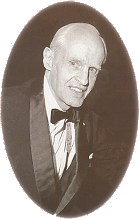The Matchless Albert
K. Murray
Was he America's foremost portrait painter—after Sargent?

Albert
Murray
1906-1992 |
 here
are those who believe that the greatest of all
American portrait painters—after John
Singer Sargent—was Albert Murray, the
legendary New York artist (1906-1992) who created
some of the most memorable and effective portraits
ever painted in this country. An Albert Murray
portrait was characterized by consummate draftsmanship,
exquisite color, flawless craftsmanship—resulting in a truly penetrating rendition of
the personality of the subject. Here are four
outstanding examples of Al Murray's magnificent
art: here
are those who believe that the greatest of all
American portrait painters—after John
Singer Sargent—was Albert Murray, the
legendary New York artist (1906-1992) who created
some of the most memorable and effective portraits
ever painted in this country. An Albert Murray
portrait was characterized by consummate draftsmanship,
exquisite color, flawless craftsmanship—resulting in a truly penetrating rendition of
the personality of the subject. Here are four
outstanding examples of Al Murray's magnificent
art:
 |
1. A Business Executive
This portrait of a contemplative
man (his identity is unknown) demonstrates
Albert Murray's skill at its utmost
and best. The pose is natural and
yet unconventional. The meditative
pose sets the painting apart from
the ordinary "corporate"
portrait. The light falls from a
single source to our right. The
subject's very natural pose creates
a rumpled shirt and necktie—very different from the usual crisp
"executive" look. The
draftsmanship of the hands is breathtaking.
Even the reflections on the lenses
of the eyeglasses breaks a conventional
portraitists' taboo. The result
is a human portrayal that is gripping
in its realism, and makes the usual
"executive portrait" seem
very ordinary indeed.
Oil
on canvas
38 x 30 inches
Private collection (unknown)
|
|
Albert Murray
was a Navy officer and combat artist during
World War II. His vivid portrayals of naval
combat action, as well as his distinguished
portraits of naval officers are among his strongest
work. A bachelor, Murray lived with his sister
on West Sixty-Seventh Street in New York for
many years, where he painted in an elegant two-story
studio.
I recall Al Murray
as a slender, soft-spoken gentleman with a warm,
gracious manner. He was a hard worker. Reluctant
to give up his portraits, he retained them in
the studio for years as he continued to make
small improvements and refinements, often to
the frustration of his clients.
Laurence S. Rockefeller,
in his foreword to the catalog of a 1995 retrospective
exhibition of Murray's work at Christie's New
York wrote very feelingly about Albert Murray
the man:
|
"His genius, I believe, was in seeing
the creative character in the people he
painted and that was the spirit that showed
through in his art. That is a rare and
beautiful, wonderful aptitude.
"His art must be viewed as an amazing
spiritual force. He was very selfless,
always seeking out the other person rather
than himself and to him everything else
was subordinate. When you are dealing
with the spirit, the mind and body become
one so all the worldly aspects seem to
disappear and only the spirit seems to
remain, so that one is hardly aware of
details.
"Al was looking in depth for soul.
It would emerge and grow on the canvasses.
Painting portraits, especially for Al,
could take a long time. He was a good
story teller, and he had human interests
to share. That's how he enlivened the
long sessions.
"Combat art forced him into another
style. He was good in that too. He loved
the Navy and made a whole new realm of
friends in shared admiration for it.
"Al's loyalty to friends engendered
strong loyalties in return. The goodness
and creativity that Al saw in others are
sketched in his work."
|
Today, only a
dozen years after his death, Albert Murray's
name is rarely mentioned. But his masterful
portraits hanging in institutions and collections
all across the country are an enduring legacy.
The extraordinary standard which he set may
never be surpassed.
Albert Ketcham
Murray, a native of Kansas, studied art
at Cornell University and then graduated cum
laude from Syracuse University. He also studied
in England and France and received special tutelage
for two years in Mexico from the noted portrait
artist Wayman E. Adams. By the late 1930's,
Mr. Murray was exhibiting his paintings at such
prestigious art institutions as the Corcoran
Gallery in Washington, D.C., and the Carnegie
Institute in Pittsburgh.
In March 1942
he was commissioned a lieutenant and line officer
in the U. S. Naval Reserve and was soon transferred
to the service's new combat art program. He
painted portraits of the members of the Navy's
General Board and did a series of paintings
of crew members from the damaged cruiser the
"U.S.S. Boise." He was assigned to
the Fourth Fleet in the South Atlantic, then
to the Eighth Fleet in the Mediterranean, where
his dog tags were shot off while he painted
scenes of the invasion of Southern France. Mr.
Murray also was awarded the Bronze Star and
promoted to the rank of commander.
After the war,
he remained on active duty to paint a series
of portraits of the Navy's top-ranking flag
officers in their wartime roles, including Fleet
Admiral Chester W. Nimitz signing the peace
accord with Japan aboard the "U.S.S. Missouri."
He was awarded the Navy's Meritorious Public
Service Award and the Navy's Distinguished Public
Service Award. After the war, he resumed his
career as a portraitist, maintaining a studio
in New York City. He died in 1992.
Biography by Marion S. Gilliland, from the
catalog of the retrospective exhibition of Albert
Murray's work at Christie's New York, December
19 - 21, 1995.
|